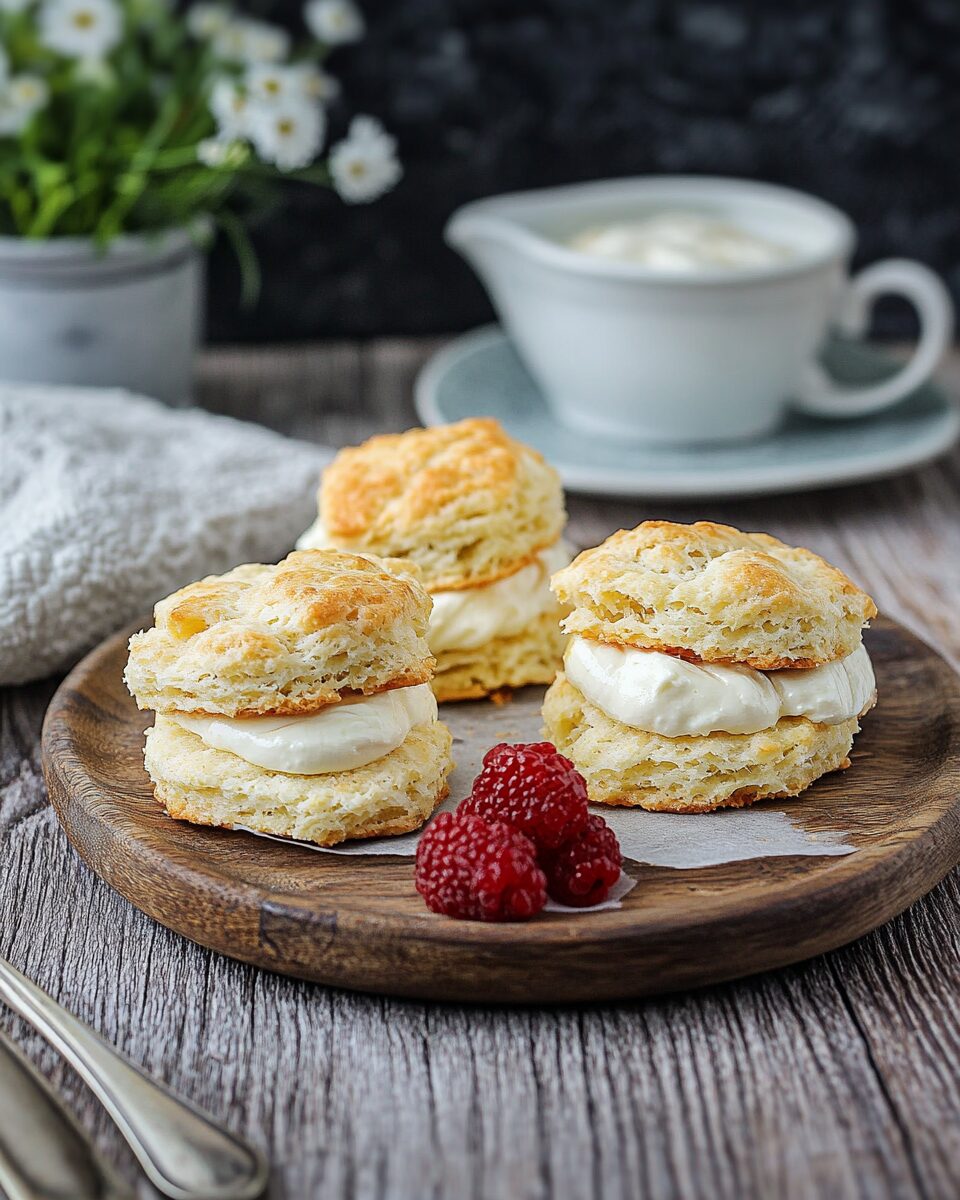There’s nothing quite like the charm of a freshly baked Irish scone. Golden brown, flaky on the outside, and irresistibly soft inside, these scones are the perfect balance of buttery richness and subtle sweetness. A classic in Irish cuisine, they are often enjoyed with a hot cup of tea and a generous spread of jam and clotted cream.
The secret to the perfect Irish scone lies in the buttermilk, which gives it a delicate, tender crumb. With a simple list of pantry staples, you can create a delightful baked treat that’s great for breakfast, afternoon tea, or a comforting snack any time of day. Serve them warm with your favorite spreads, and enjoy the taste of Ireland in every bite.
Full Recipe
Ingredients:
- 2 cups (250g) all-purpose flour
- 1/4 cup (50g) granulated sugar
- 2 teaspoons baking powder
- 1/2 teaspoon baking soda
- 1/2 teaspoon salt
- 1/4 cup (57g) unsalted butter, cold and cubed
- 1/2 cup (120ml) buttermilk
- 1 large egg
- 1 teaspoon vanilla extract
- 1/2 cup (75g) raisins or currants (optional)
- 1 egg yolk mixed with 1 tablespoon milk (for egg wash)
Directions:
- Preheat the Oven: Preheat your oven to 400°F (200°C). Line a baking sheet with parchment paper.
- Mix the Dry Ingredients: In a large bowl, whisk together the flour, sugar, baking powder, baking soda, and salt.
- Incorporate the Butter: Using a pastry cutter or your fingers, rub the cold butter into the dry ingredients until the mixture resembles coarse crumbs.
- Prepare the Dough: In a separate bowl, whisk together the buttermilk, egg, and vanilla extract. Slowly pour this mixture into the dry ingredients, stirring gently with a fork.
- Fold in the Add-ins: If using raisins or currants, fold them in at this stage. Do not overmix the dough.
- Shape the Scones: Turn the dough onto a lightly floured surface and gently knead a few times. Roll out to about 1-inch thickness and cut out scones using a round cutter.
- Apply Egg Wash: Place scones on the prepared baking sheet and brush the tops with the egg yolk and milk mixture for a golden finish.
- Bake to Perfection: Bake for 12-15 minutes or until the scones are golden brown on top.
- Serve: Allow to cool slightly before serving warm with butter, jam, or clotted cream.
Prep Time: 10 minutes | Cooking Time: 15 minutes | Total Time: 25 minutes
Kcal: 210 kcal | Servings: 8 scones
The Ultimate Guide to Traditional Irish Scones
Irish scones are a beloved treat deeply rooted in Ireland’s culinary traditions. These classic baked goods, known for their golden crust and tender crumb, have been a staple in Irish homes for generations. Unlike American biscuits, Irish scones have a slightly sweeter taste and a denser texture, making them a perfect companion for tea or coffee. Whether enjoyed plain or with butter, jam, or clotted cream, they are an essential part of Irish heritage.
The History of Irish Scones
Scones have been a part of Irish and British baking traditions for centuries. The origin of the word “scone” is believed to come from the Dutch word schoonbrood, meaning “fine bread.” Historically, Irish households relied on simple, readily available ingredients to make their bread and baked goods. Before modern ovens, scones were cooked on griddles or open fires, often made with buttermilk and baking soda rather than yeast. This tradition continues today, with buttermilk playing a key role in giving scones their signature light texture and slight tangy flavor.
Why This Recipe Stands Out
This recipe for traditional Irish scones is a tried-and-true method that captures the authentic taste and texture of a perfect scone. Unlike overly complicated versions, this recipe stays true to Irish baking traditions by using simple, wholesome ingredients. The result is a beautifully golden, slightly crispy exterior and a soft, flaky interior.
Key Characteristics of Irish Scones
- Golden, flaky crust – A proper Irish scone should have a lightly crisp, golden brown crust that provides a delicate contrast to the tender inside.
- Tender and buttery texture – Buttermilk adds a slight tang and helps keep the scones moist, while butter ensures a rich, satisfying bite.
- Slightly sweet flavor – Unlike American biscuits, Irish scones have a gentle sweetness that makes them perfect for pairing with jam, honey, or fresh fruit.
- Perfect with tea or coffee – A warm scone with a cup of strong tea is a quintessential Irish experience.
How Irish Scones Differ from Other Scones
- Irish vs. British Scones – While both are similar, Irish scones tend to be slightly denser and richer due to the buttermilk and butter content.
- Irish vs. American Biscuits – American biscuits are typically flakier and less sweet, often served as a savory side dish rather than with tea.
- Irish vs. Scottish Scones – Scottish scones are often made with oats and are slightly drier than Irish scones.
Tips for Making the Best Irish Scones
- Use Cold Butter – Cold butter creates small pockets of fat in the dough, resulting in a tender and flaky texture.
- Don’t Overwork the Dough – Overmixing can make the scones tough. Handle the dough gently to keep it light.
- Use Buttermilk for Authentic Flavor – Buttermilk adds moisture and tang while helping the scones rise properly.
- Chill Before Baking – Chilling the dough for a few minutes before baking can help create a better texture.
- Use an Egg Wash for a Golden Finish – Brushing the tops of the scones with an egg yolk and milk mixture ensures a rich, golden color when baked.
Serving Suggestions
Irish scones are incredibly versatile and can be served in many ways. Traditionally, they are enjoyed warm with butter and jam, but there are plenty of delicious variations to explore:
- With Clotted Cream and Jam – A classic combination often served at afternoon tea.
- Drizzled with Honey – For a naturally sweet flavor.
- Topped with Fresh Berries – Strawberries, raspberries, or blueberries complement the mild sweetness of scones.
- Served with Irish Butter – High-quality Irish butter enhances the scones’ rich, creamy taste.
- Accompanied by a Cup of Tea or Coffee – The traditional Irish way to enjoy a scone.
Best Variations of Irish Scones
While traditional Irish scones are simple and classic, there are many variations you can try:
- Fruit Scones – Add raisins, currants, or dried cranberries for a lightly sweet and fruity touch.
- Cheese Scones – Incorporate shredded cheddar cheese and a pinch of black pepper for a savory version.
- Herb Scones – Add fresh herbs like rosemary, thyme, or chives for a fragrant twist.
- Whole Wheat Scones – Use whole wheat flour for a heartier, more fiber-rich option.
- Spiced Scones – Add cinnamon, nutmeg, or cardamom for a warm, aromatic flavor.
How to Store and Reheat Irish Scones
- At Room Temperature – Store scones in an airtight container for up to 2 days.
- In the Refrigerator – Keep scones fresh for up to 5 days in a sealed container.
- Freezing Scones – Freeze baked scones for up to 2 months. Thaw and warm in the oven for best results.
- Reheating Tips – Warm scones in a 300°F (150°C) oven for 5-7 minutes or microwave for 15-20 seconds.
Cultural Significance of Irish Scones
Scones are more than just a delicious treat; they hold cultural significance in Ireland. Often served at family gatherings, tea parties, and holidays, they bring people together over a shared love for homemade baked goods. Irish hospitality is well-known, and offering a guest a warm scone with tea is a sign of warmth and welcome. Many Irish grandmothers have their own cherished scone recipes, passed down through generations.
Conclusion
Traditional Irish scones are a timeless classic that embodies the simplicity and warmth of Irish baking. With their golden crust, soft interior, and slightly sweet flavor, they make the perfect treat for breakfast, tea time, or an afternoon snack. This recipe stays true to authentic Irish traditions, ensuring that each bite delivers the perfect balance of rich, buttery goodness. Whether served plain or with your favorite toppings, Irish scones are a comforting delight that should have a place in every home baker’s repertoire.
For those looking to explore the art of traditional baking, making Irish scones is a fantastic place to start. The process is simple, the ingredients are minimal, and the results are always rewarding. Whether you’re enjoying them fresh out of the oven or sharing them with loved ones over tea, these scones bring a little taste of Ireland into every bite.






